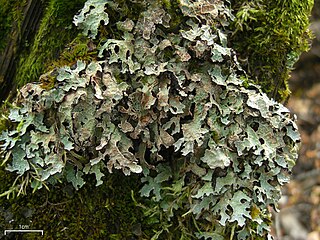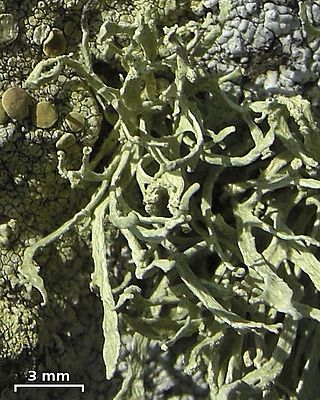
Ramalina fraxinea, the cartilage lichen, is a fruticose lichen with erect or pendulous thalli and branches that are flattened. Colour varies from pale green though yellow-grey to white-grey; apothecia are frequent and soralia may also be present.

Ramalina is a genus of greenish fruticose lichens that grow in the form of flattened, strap-like branches. Members of the genus are commonly called strap lichens or cartilage lichens. Apothecia are lecanorine.

Niebla is a genus of yellow-green fruticose lichens that grow on rocks, trees, and shrubs within the fog zone of coastal North America, or more narrowly defined to occur on rocks and soil along the Pacific Coast from Mendocino County in California south to Baja California Sur.
Relicina colombiana is a species of saxicolous (rock-dwelling), foliose lichen in the family Parmeliaceae. Found in high-elevation páramo of the Eastern Cordillera in Colombia, it was described as new to science in 2011.
Parmelia asiatica is a species of corticolous (bark-dwelling) foliose lichen in the family Parmeliaceae. It occurs in China and the Russian Far East, where it grows on Rhododendron tree trunks in temperate regions. It was Described as new to science in 2011 by lichenologists Ana Crespo and Pradeep Divakar. The species is distinguished by its terminal soralia, marginal linear pseudocyphellae, and chemical composition, which includes the substances atranorin and salazinic acid. Parmelia asiatica is similar to Parmelia protosulcata but differs in the presence of salazinic acid and its distribution in Southeast Asia.

Ramalina farinacea is an epiphytic bushy shaped (fruticose) lichen common to areas with Mediterranean, subtropical, or temperate climates. It is in the genus Ramalina of the family Ramalinaceae. The coexistence of two different species of the Trebouxia genus of green algae at the same time were found to be in each specimen collected in widely distributed populations. The algae thrive in different temperature and light environments. It is thought this demonstrates an ability of the lichen with two simultaneous green algae partners to proliferate in a wider range of habitats and geographic areas.
Vermilacinia cephalota is a fruticose lichen usually found on trees, shrubs and wooden fences in the fog regions along the Pacific Coast of North America from southeastern Alaska to the Vizcaíno Peninsula of Baja California.
Vermilacinia leonis is a fruticose lichen usually found on branches of shrubs in the fog regions along the Pacific Coast of North America and South America; in North America it is found on the southern half of the main peninsula of Baja California north to the southern coast of the Vizcaíno Peninsula. In South America, it occurs on bushes and rocks in Chile; reported from Colchaqua (Valley) and Santiago The epithet is in regard to absence of the black transverse bands often seen in other species such as V. leopardina, V. tigrina and V. zebrina.
Niebla cornea is a fruticose lichen that grows along the fog regions of the Pacific Coast of North America from near Morro Bay, California to near Punta Santa Rosalillita in Baja California. The epithet, cornea, is in reference to the cortex appearing hard and close textured.
Niebla disrupta is a fruticose lichen that grows on rocks along the foggy Pacific Coast of California, from Marin County to San Luis Obispo County, in the Channel Islands, and on Guadalupe Island in Baja California. The epithet, disrupta was given by William Nylander possibly in reference to the terminal vine-like branchlets exhibiting a disruption or slight change in the direction of growth where apothecia develop, or possibly to the branchlets that appear to break off.
Niebla laminaria is a fruticose lichen that grows on rocks along the Pacific Coast of North America within the California Floristic Province, from Marin County, California south to Misión San Vicente Ferrer in Baja California, and in the Baja Channel Islands. The epithet, laminaria is in reference to the thallus divided into blade-like branches similar to a genus of brown algae, Laminaria.
Ramalina erosa is a species of fruticose lichen in the family Ramalinaceae. It was described as a new species by Hildur Krog in 1990. The type specimen was collected from Pico do Facho on Porto Santo Island (Portugal), where it was found growing on acidic rock at an elevation of 500 m (1,600 ft).
Anzia centrifuga is a species of foliose lichen in the family Parmeliaceae. It is found only on one volcano on Porto Santo in the Madeira Archipelago, where it grows on rocks.

Megalospora is a genus of lichen-forming fungi in the family Megalosporaceae.

Salazinic acid is a depsidone with a lactone ring. It is found in some lichens, and is especially prevalent in Parmotrema and Bulbothrix, where its presence or absence is often used to help classify species in those genera.

Parmelia barrenoae is a species of foliose lichen in the large family Parmeliaceae. It was formally described as a new species in 2005. Before this, it was lumped together as one of several lichens in the Parmelia sulcata group—a species complex of genetically distinct lookalikes. Parmelia barrenoae is widely distributed, occurring in Europe, western North America, Africa, and Asia.

Sekikaic acid is an organic compound in the structural class of chemicals known as depsides. It is found in some lichens. First isolated from Ramalina sekika, it is a fairly common lichen product in the genera Ramalina and Cladonia. The species epithet of the powdery lichen Lepraria sekikaica refers to the presence of this substance—a rarity in genus Lepraria.

Ramalina americana, commonly known as the sinewed ramalina, is a pale green fruticose lichen that is found across the Northern US Midwest, extending into Southern Canada and the Eastern Seaboard. It is characterized morphologically by the presence of pseudocyphellae, straight spores, and its unique chemical diversity.
Hypogymnia capitata is a species of foliose lichen in the family Parmeliaceae. Found in high-elevation conifer forests in Sichuan Province, China, it was described as a new species in 2014. The lichen is characterized by its capitate terminal soralia, brownish lobes with white cavities, and the presence of olivetoric acid. This lichen is distinguished from similar species by its specific morphological, chemical, and habitat characteristics.

Ramalina polyforma is a species of saxicolous (rock-dwelling), fruticose lichen in the family Ramalinaceae. This greenish-grey shrubby lichen, endemic to the Galápagos Islands, was formally described as a new species in 2007 by Dutch lichenologist André Aptroot.








